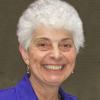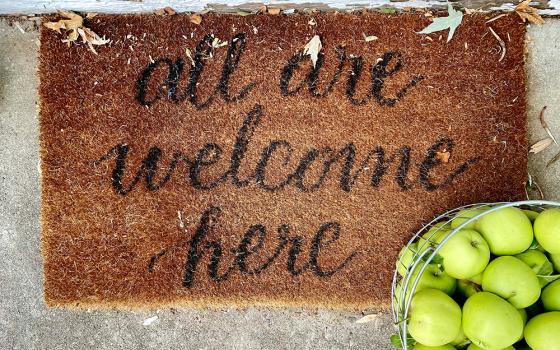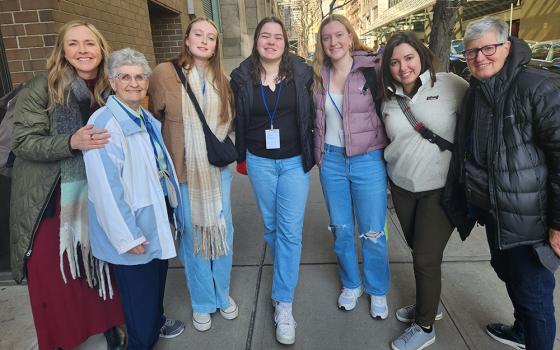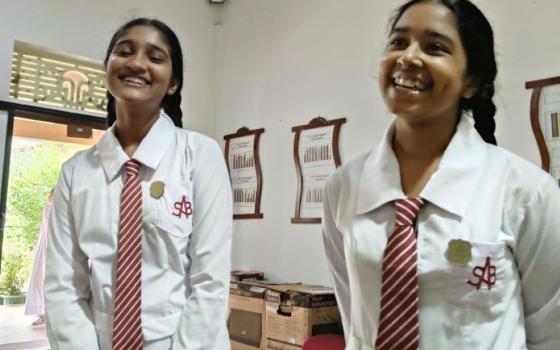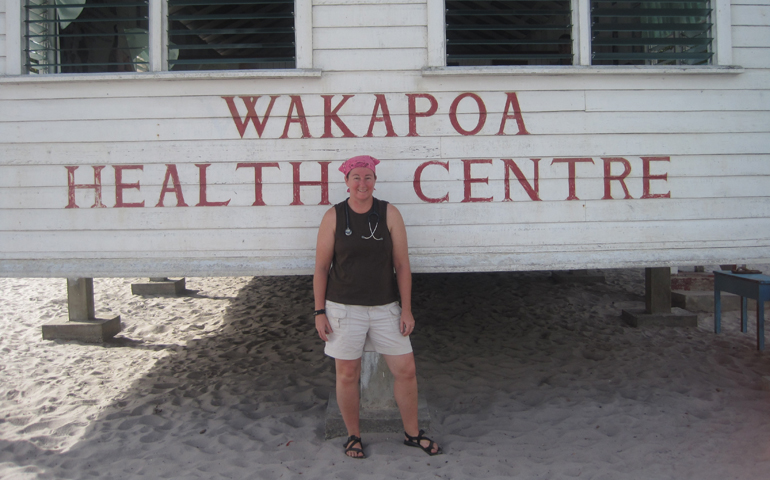
Sr. Karen Schneider outside the Wakapoa Health Center in Guyana's interior
While so many of us worry about the lack of pediatric care in depressed areas of the world, Mercy Sr. Karen Schneider, a pediatrician at Johns Hopkins Children's Center, has found a creative, positive way to address children's needs by founding Mercy Medical Missions.
Sr. Camille: When and how did this come about?
Schneider: When I was a fourth-year medical student, I did an international elective in Guyana, South America, for two months. We Sisters of Mercy have a hospital there, and I thought it would be a neat experience to spend some time in a hospital that was run by my Mercy sisters and at the same time learn some tropical medicine.
While there, I was able to go into the interior of Guyana and live and work with the Amerindians. I got off a small plane and walked right into a malaria epidemic that was plaguing the village. The school was closed; there were hundreds sick; some had already died. I had a two-hour lecture in malaria, then immediately got to work giving malaria medicine intravenously to those who couldn't take the medicine by mouth because they were vomiting. I was also able to give fluid boluses to those who were severely dehydrated. After I arrived, no one died. It was not because I was a brilliant medical student. It was because of a simple intervention: placing an IV. I realized that there are people "out there" who suffer or die from not having basic health care or simple surgeries and maybe I could make a difference in some of these communities.
How do you establish your teams of professionals and volunteers?
Since it was such a valuable experience for me as a young physician in training, I wanted to create that experience for the young physicians in training at Johns Hopkins University, so I created a tropical medicine elective class. Pediatric residents and emergency medicine residents can sign up for the elective and travel with me to Guyana, Haiti, Kenya and Nigeria. Depending on the country and the needs, I then build a team around these residents, including nurses, maybe a surgeon and sedation/anesthesia physician, or some specialists like a pediatric cardiologist or a dentist or OB-GYN.
Please tell us about some of your companions on these journeys.
There are a few people whom I call "repeat offenders." They have returned for many trips and have become the core. Nayra Zimmerman is a nurse at Johns Hopkins, and she helps put together the surgical component of the trips to Haiti, Kenya and Nigeria. Dr. Karen Cartwright is a pediatric surgeon from California who has actually decreased her working time in the U.S. to 50 percent so that she can go on mission trips to "fix" poor children in various countries. Karen goes on three trips a year with us. Because of Karen and Nayra, this past year we did 126 surgeries!
Several Sisters of Mercy are among the regulars. Sr. Susie Ashton from Baltimore is an OB-GYN, and she has gone on multiple trips. She examines the teenage girls and answers all their "girl" questions. Sr. Mary McGrory of Queens, N.Y., is a nurse who goes on every trip to Haiti and Guyana. She loves the jungle of Guyana. Sr. Mary Ellen Brody from St. Louis is fluent in Spanish and again has been on multiple trips that require a Spanish translator.
Is there a value in returning to the same countries?
At present, we visit Guyana, Haiti, Kenya and Nigeria because our return trips allow us to establish relationships with the people whose needs we know. The more often I go to a country, the more connections I make and the more we can get done to address the needs of the community.
How many trips per year?
There are always four trips a year with the residents, but occasionally, I need to go back to a country with a smaller team to perform surgeries. For instance, we had gone to a new place in Haiti and came across so many children who needed surgical procedures. We were able to do 50 surgeries on that trip, but as the days went on, the waiting list was getting longer and longer. It was obvious we were never going to be able to perform them all. So we planned on returning to Haiti with a smaller surgical team a few months later to do another 50-plus surgeries.
Which countries are most demanding and why?
At present, Nigeria is the challenge. We went there for the first time in August and were overwhelmed! The government is not providing health care in the rural areas. Each day, we had to turn away hundreds of children even as we had to jump through many hoops to get electricity and to sterilize instruments. We managed to get 19 surgeries done but left 60 on the waiting list. When we return next time, we'll be more prepared with a bigger team and an instrument sterilizer that will be effective in Nigeria.
Which destination is the easiest for your team?
I think Haiti is the easiest. It's the shortest plane ride, and we have running water and electricity most days -- all the comforts of home! What makes all the countries difficult is the dire poverty that our residents witness. Many see this in person for the first time. It's the first time they have actually examined a child who is hungry and malnourished. It is the first time they hear a mother say, "I have no food to give to my child."
Are you connected with other religious organizations that perform services comparable to yours?
None that are based in the United States, but we do connect with religious organizations or communities in the various countries. We work with the Religious of Jesus and Mary in Haiti and the Sisters of Mercy in Guyana and Kenya.
How do you finance these trips?
Donations, donations, donations! I think I have the market on begging. I mean, who is not going to give money to a nun who is helping desperately poor children in developing countries with medicines or surgeries? People want to know that their money is going directly to help, and I have no overhead or administrative expenses except the price of a stamp for a thank-you note.
Who tend to be your most stalwart supporters?
The Sisters of Mercy, of course. A lot of the donations come from individual sisters who send $25 a month. A few nurses and former pediatric residents who have gone on the mission trips are monthly donors. And some of these residents who have finished their training participate in another trip as attendings and help me supervise the residents in training.
When we consider the number of sick children and desperate parents, we know there are countless stories of success and failure. Would you share one of each with us?
So many come to mind. Narissa was 12 years old and had been born with club feet. Because of this, she found it almost impossible to walk and at times, preferred crawling.
In the U.S., her feet would have been fixed as an infant and she would have been taking her first steps on corrected ankles, but in Guyana, this was not possible. She lived in the interior in a village that was so remote that her mother had never seen a car or electricity or running water.
When I told the mother that we could fix Narissa's feet but that they would have to go to Georgetown, the capital of Guyana, the mother had many excuses why they couldn't go: She didn't have the money, she had to cook for her young family, she didn't know the way. It was just impossible. Nestled in these excuses was fear. It would be equivalent to my telling you, "You are just going to go to the moon for a week, but don't worry: I will pay for it and give you food, and you will return."
The mother did not budge in her decision. I then did something outside the norm of the culture. I addressed the child in front of the parent: "Narissa, do you want to have the surgery?" And with tears in her eyes, she said, "Oh, yes, white lady doctor, I want to walk!" It was then that the community health worker from that village volunteered to take the long journey and accompany this mother and daughter. When we visited the village the next year, Narissa was wearing sandals, the first shoes of her life, and she ran to give me a hug.
That's a wonderful story! But now describe a failure.
We'd just returned from northern Kenya, where we'd spent 12 days with the Samburu peoples. These folks live a very traditional tribal life. They are pastoralists who herd camels, cattle and goats and move around following the rains and grass to feed their animals. They live in stick- constructed, igloo-type structures that they can pack up and carry with them to the next pasture. The girls are "traded" into marriage at a very young age, approximately 9 years old, for 20 cattle or four camels. This allows their fathers to become rich with livestock. The boys are warriors from the ages of 15 to 30, guarding the livestock and the village. We had gone from village to village examining the children and found many who needed surgery. The mothers were very willing, but the fathers were hiding in the mountains with the livestock because they were at war with the Turkana tribe. The women were not allowed to make a decision without the men. Thus we had a surgeon, a clinic and sick children, but no permission to do the surgeries. It was frustrating, and we left having learned a lot about the Samburu people but without being able to perform the surgeries the children needed.
What have you learned from the people you've met along the way?
That mothers and fathers are the same everywhere: They love their children and want the very best for them.
Where did you grow up?
I grew up on Long Island, N.Y., in Lynbrook with my mom, dad and a brother, John, who was two years younger than me.
What schools did you attend?
Our Lady of Peace Elementary in Lynbrook. Sacred Heart Academy, Hempstead. I graduated from Molloy College in 1984. Twelve years later, after teaching in my community's schools, I graduated from SUNY Downstate's medical school, did my pediatric residence at Yale University, then obtained a Pediatric Emergency Medicine Fellowship at Johns Hopkins University.
What drew you to the Sisters of Mercy?
I had a God experience when I was a teenager on an Antioch retreat for teenagers. It was a powerful experience. I truly felt touched by God and for the first time, God became real in my life. I joined the teen group and every Wednesday, we would come together and pray and then have a social.
On Saturdays, this teen group would volunteer around the parish. As I got older, I had this desire to live in community, pray and do good works, so folks would say, "Oh, you want to be a nun." And I would think, "No way. I want to be normal!"
But then I started meeting sisters who were doing these amazing things. Sr. Eileen Hogan was a prison chaplain at Rikers Island. As you can imagine, it was a tough job, and she was a tough lady. I was mesmerized by her, that she could be merciful and yet strong and stern at the same time. Then I met three other Sisters of Mercy -- Assunta Boyle, Eileen Trainor and Anne Carron -- who worked and lived at the soup kitchen in Wyandanch. They didn't live in some nice neighborhood and drive into work; they lived right there in the neighborhood with the people they served. These sisters lived in community, prayed together and did good works. It was then that I thought that maybe I wanted to explore this life.
When did you decide you wanted to become a doctor?
I always wanted to be a doctor, but in my college years, I kind of knew that I wanted to be a sister, and I knew I had to make a choice. The calling to be a sister was much stronger. I entered the community thinking I'd never be a doctor. So in college, I majored in mathematics education for seventh- to 12th-graders then taught high school mathematics at Catherine McAuley High School for seven years during my initial formation in the community. After my final vows, the leadership team asked me what advanced degree I'd like to pursue. I boldly proclaimed that I wanted to study medicine and, to my surprise, got a green light from the community.
Do you ever experience danger?
With all the traveling I do, there have been some hiccups along the way. But thankfully, I and my team have survived every adventure. Our car was washed away in a river crossing in Haiti, but thankfully, some men jumped into the river and pushed us to the other bank before it tipped.
Again in Haiti, I was able to get there just days after the earthquake and was there for the 6.0 aftershock. The house I was in swayed powerfully and I had to hold onto the bed not to get thrown out of it, but the building did not collapse.
In Brooklyn, I had a knife pointed at me by a drug addict, and in northern Uganda, had an AK-47 pointed at me. On both occasions I was robbed but left both scenes unhurt. In the interior of Guyana, we bathe in the Pomeroon River that is filled with anaconda (30-foot snakes) and cayman (crocodiles). Thus far we have not been eaten.
In addition to offering thanks, how do you pray?
I like to pray in the early mornings and greet the day as the sun comes up, which is easier to do in the wintertime since the sunrise is a little later. I live with one other sister. Most mornings, sometimes evenings, she and I will read the Scripture of the day and reflect on the passages. I like faith sharing. It is one of the reasons I like living communal life, to have people to pray with and share the journey.
What is your favorite Scripture passage?
My favorite passage is the widow's mite. Here this woman has just a little to give, and yet she gives it and God looks favorably on her. It helps me remember that it is the small things that count: the smile, a kind word, a few dollars. I too hope that the little I give will be enough.
What is your image of God?
I feel God as my constant companion. It is hard to explain, but there is this God deep inside me that is always there in the good times and in the bad times. I can't put words to it. I just feel loved.
What gives you joy?
Spending time with my sisters in community. Feast days, celebrations, professions, community meeting days and even the funerals that bring us together. I look forward to all these events. At each and every occasion, I look around the room and see amazing women who inspire me: teachers, social workers, hospital administrators, college presidents, nurses, lawyers, parish workers, doctors -- each woman trying to make a little difference in the people she touches every day. Can you tell that I am very happy to be a Sister of Mercy? It was the right life choice for me!
Why do you do continue your work with poor children?
My reason for doing these trips is twofold: to serve poor children and to open the eyes of the fortunate to the less fortunate. So many people have said, "This trip changed my life." Indeed, some of the young physicians have made different life choices because of their experience on the trip. I long to make people a little more aware that children are suffering and that with just a little bit of money or a small intervention, their lives can be changed. I think we in the U.S. can become too comfortable, and we have an obligation to reach out. I have been doing these trips for 12 years; 200 young physicians in training have traveled; an additional 100 people have accompanied us. Thousands of children have been touched.
And your story, Karen, touches us. Thank you.
[Mercy Sr. Camille D'Arienzo, broadcaster and author, narrates Stories of Forgiveness, a book about people whose experiences have caused them to consider the possibilities of extending or accepting forgiveness. The audiobook, renamed Forgiveness: Stories of Redemption, is available from Now You Know Media.]
Editor's note: We can send you an email alert every time Sr. Camille's column, Conversations with Sr. Camille, is posted. Go to this page and follow directions: Email alert signup.
